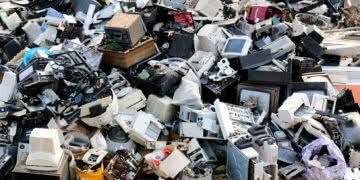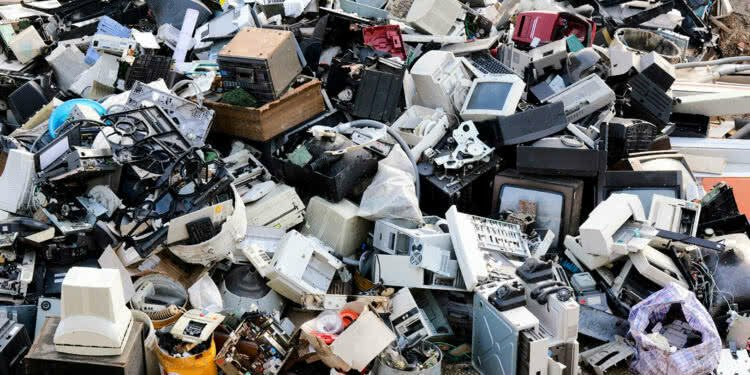As the demand for electronic devices and equipment continues to surge, so too does the amount of electronic waste being generated.
In 2017, 44.7 million tonnes of e-waste were produced globally, 90% of which was sent to landfill, incinerated, illegally traded or treated in a sub-standard way.
The US and Europe account for around half of all e-waste generated and, according to the European Commission (EC), the European Union will generate a total of 12mn tonnes of electronic waste in 2020, up from 9mn tonnes in 2005.
Waste of electrical and electronic equipment, or WEEE, is one of the fastest growing waste streams in the EU. The UK alone produces 24.9kg of e-waste per person, compared to an EU average of 17.7kg.
In the UK, electronic waste is managed under the EU’s Waste Electrical and Electronic Equipment (WEEE) Directive and The Waste Electrical and Electronic Equipment Regulations 2013.
A collective producer responsibility scheme also exists, whereby producers have a financial responsibility for the end-of-life of their goods, which is calculated by market share, but they do not have to reprocess their own goods. Collections are carried out via Household Waste Recycling Centres and take back schemes are run by retailers or local authorities.
The Department of Environment, Food and Rural Affairs (DEFRA) sets annual targets for the collection of WEEE that are calculated based on the WEEE Directive’s target of 65% of the average annual weight of electrical and electronic equipment placed on the market over the previous three years. The target for 2019 has been set at 550,577 tonnes, a 12% increase on 2018 levels.
It’s an ambitious target, according to DEFRA, but is needed in order for the UK to meet its EU obligations. However, while the UK may be setting targets to handle, recycle or dispose of its electronic waste it is struggling to meet them, having missed its 2018 targets by some 40,000 tonnes.
“We certainly aren’t seeing the growth in recycling needed to meet these targets,” says Susanne Baker, Head of Programme, Environment and Compliance at techUK. “There are a number of reasons behind this. But primarily, there’s a lack of awareness – consumers don’t know how to dispose of EEE correctly and facilities to recycle WEEE aren’t conveniently located for many.”
In the UK, large household appliances make up 40% of WEEE and according to Pascal Leroy, Secretary General at the WEEE Forum finding a recycling facility can be a real effort. “It’s the same reason people litter; there’s no bin within easy reach.”
He also warns that discarded electronics can invite scavenging. “Criminals see end of life components, particularly valuable ones and know they can make a profit,” Leroy contends. “Up to 25% of certain WEEE categories in the EU end up being stolen.”
A tsunami of e-waste
The Chair of the UK Parliament’s Environmental Audit Committee, Mary Creagh MP, has warned of a ‘tsunami of e-waste’.
“New phone launches, cheaper goods, and built-in obsolescence have contributed to the growth of electronic waste in recent years,” she says, “We are missing EU targets and are one of the worst offenders for exporting waste to developing countries, who are ill equipped to dispose of it in a socially and environmentally responsible way.”
According to Creagh, the UK’s attitude towards e-waste is unsustainable and that there’s a need for ‘radical action’, hence the decision by the Environmental Audit Committee to announce a new inquiry into Electronic Waste (e-waste).
The committee will be looking at what steps are being taken to move towards a circular economy for electronic goods and how the UK Government can support that transition. The committee will also be looking at the environmental and human health risks associated with e-waste and how secondary markets for electrical goods can be improved.
It will also investigate how we go about recovering materials from electronic waste and what support is required to facilitate the adoption of recovery technologies.
Crucially, it will assess whether the UK Waste Electrical and Electronic Equipment (WEEE) collection targets are actually achievable and how we better manage fraud and the illegal exporting of waste.
The fact that the Environmental Audit Committee is launching an inquiry into Electronic waste was welcomed by techUK’s Baker: “While we are recycling half of all consumer electrical products and are achieving even higher recycling rates for electronics, clearly more must be done.
“In particular, the focus on illegal waste shipments is very welcome. Producers have noted, with concern, recent reports highlighting illegal activity in the UK and look forward to working with the Committee to consider what additional steps can be taken to stamp out this activity.”
The old saying ‘where there’s muck, there’s brass’ is certainly true of e-waste and investigation by the environmental watchdog the Basel Action Network (BAN), discovered that the UK is the worst offender in the EU when it comes to illegal shipping of WEEE.
“If there is more liability than value in the waste, there is an incentive to dump or export to developing countries where it’s easy to externalise the liabilities to the environment or people’s health,” explains Jim Puckett, Executive Director (BAN).
In a two-year study, BAN looked at 10 EU countries (Austria, Belgium, Denmark, Germany, Hungary, Ireland, Italy, Poland, Spain, and the UK), placing GPS trackers secretly into 314 printers, computers and monitors.
“The EU and its member states are currently global leaders on environment. Nevertheless, there was a lot of anecdotal information and concern over waste leakage from the EU to developing countries,” Puckett explains.
This tracked equipment was monitored and significant amounts were illegally shipped to Ghana, Hong Kong, Nigeria, Pakistan, Tanzania, Thailand, and Ukraine.
Using figures regarding WEEE generation in Europe, if extrapolated, BAN calculated that over 350,000 metric tonnes per annum were being shipped abroad in this way.
In those destination countries, BAN found that the e-waste was often subjected to substandard, dangerous recycling operations leaving workers dangerously exposed to techniques like burning, melting, or chemical acid stripping which are used to extract copper, gold, steel, and aluminium. While some of the equipment was repaired, even in these cases, toxic parts containing substances such as mercury, lead, and brominated flame retardants which could not be reused, were discarded or burned in local dumps.
“It’s difficult to catch out exporters of non-functional broken electronic equipment (illegal) and distinguish these from exporters of functional used equipment (legal),” explains Puckett. “We simply don’t have enough inspectors in countries like the UK.
“This is one of the reasons we used GPS trackers. We know that the equipment we put them into are not functional and are non-economically repairable. We also know they are toxic, and we were able to follow them via satellite technology wherever they went in the world.”
Puckett did say that there are a number of excellent recyclers in the UK and there are diligent enforcement agents, but in order to combat illegal trade, it needs to be even better. “That includes stiffer penalties for perpetrators,” he argues.
The value of e-waste
Electronic waste (e-waste) is hugely valuable and is estimated to be worth at least $62.5 billion annually. That’s equivalent to the GDP of a country like Kenya.
The value comes from the use of high value metals in electrical components such as gold, silver, copper, platinum and palladium and there has been a significant development in second-hand markets for products such as smartphones.
E-waste can contain up to 60 different metals and chemicals, some of which can be hazardous to human health and the environment. Waste can end up contaminating soil, polluting water sources and entering the food supply chains, while the use of crude recycling techniques, such as burning plastic from goods to harvest the valuable metals, can result in workers being exposed to toxic substances and carcinogens leading to health problems.
The UK was ranked as the worst offender in the EU by BAN and following the report’s publication, the Environment Agency closed down four illegal waste operators in the UK.
The export of e-waste from developed countries to developing countries has been identified as a global challenge and the UN has called for binding agreements on the classification of waste and stronger national legislation and enforcement.
Despite that, earlier this year, countries were unable to reach agreement on proposals for sustainable e-waste management under the Basel Convention. These will be reviewed again in 2021.
The UK Government has committed itself to publishing a review of the 2013 WEEE Regulations this year and is consulting on changing WEEE by the end of 2020. It has said that it will consider ideas to incentivise sustainable product design and increase recycling and has committed £8 million in funding over the next three years to support research, behaviour change and local projects to boost reuse and recycling.
According to Baker the Government will also need to address the reluctance to recycle due to data concerns, with some consumers unaware of how to wipe data from their mobiles and computers.
“A growing number of users are actually hoarding these items as a result,” she says, and while this means these items won’t end up in land-fill, it does reduce the amount of waste the UK can collect.
In response, techUK is developing a three-year national consumer communications campaign to increase the amount of electrical and electronics that are recycled and reused – with a view to start testing/piloting the campaign later this year before full roll out in 2020.
All of this should be welcomed but as we can see from BAN’s research the UK – and the rest of the world – need to do a lot better.















